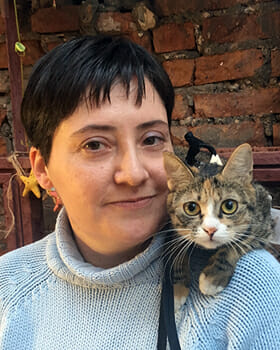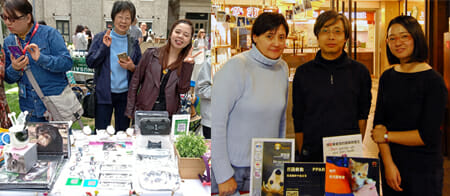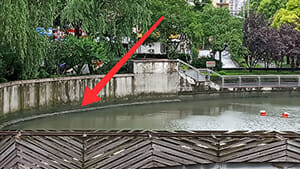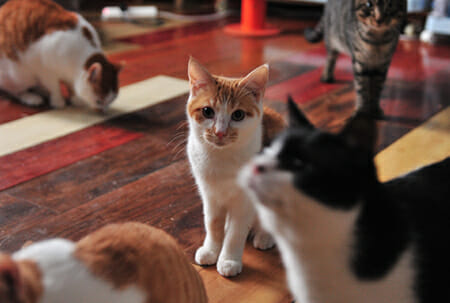Paw Pals Animal Rescue (PPAR) is a non-profit organisation established in 2007. It focuses on rescuing cats in Shanghai, China, providing them with shelter, love, and medical care while finding their forever homes. Waldo’s Friends chatted with Alejandra Vasquez Delama, a senior volunteer who spends most of her time spreading the word about the cause and saving cats.
Help out by donating to
Paw Pals Animal Rescue (PPAR)
With your kind assistance, PPAR can provide more assistance, shelter, care, rehabilitation, and forever loving homes to rescued pets.
Waldo’s Friends (WF): Could you share a brief history on how the rescue came about?

Alejandra Vasquez Delama (AVD): Paw Pals Animal Rescue (PPAR) was founded in 2007 by a group of individual animal rescuers that did not have safe or enough space to keep their rescue cats while they looked for good people to adopt them. The creation of the PPAR shelter allowed these rescuers to help even more animals in need, and has since led to permanent efforts to keep and expand the space, and provide comfort and tranquility for all rescued cats and kittens.
Our members also rescue other animals (dogs, hamsters, more), but the PPAR shelter is only for cats as they can be more discreet, require no large gardens, and can be easier to handle compared to a dog shelter. Dog barking can be a serious issue with neighbors in China.
WF: What does PPAR hope to achieve?
AVD: Our main objective is to help homeless cats in the Shanghai area, providing a mid-way home for them until they are placed in responsible, loving homes. As we already on our 12th year, we hope not only to help animals, but to reach into the local and international community in order to help build a positive human-animal bond and to spread the word on several issues (stray animal rescue procedure, vaccinations, responsible ownership, the devastating effects of animal mills, etc).
WF: How long have you been with PPAR and how are you personally involved in it?
AVD: I’ve been with PPAR for eight years. I am in charge of doing several posts about the “PPAR Adoptable Cat of the Month” across several websites every month. I am also the volunteer who pushed for the creation of the PPAR website, found the volunteers needed to build it, and the person who regularly works on uploading new news, posts, and pictures on the site.
In terms of events, I am the PPAR liaison with Community Center Shanghai and the Commune Market as PPAR is regularly invited to participate in their events. Other PPAR volunteers and I go there to represent our group and to sell our goods (100% of the proceeds go to the shelter). Regarding magazines and news websites in English and Spanish, I am also the person who is usually interviewed in connection to the activities of PPAR. Of course, besides all the activities that I just mentioned, I rescue animals on a regular basis. I have rescued mostly cats, but also I have experience rescuing dogs and other animals.
WF: What would you say has been the rescue’s most effective campaigns?
AVD: I personally believe our most effective campaign has been to develop a sustainable cat shelter (compared to other animal shelters that have poor facilities, but rely heavily on donations from sponsors to keep running). Our shelter has no sponsors, so all the funds to run it come from individual rescuers that pay a basic amount to board their rescue cats at the shelter, and from senior members of PPAR. This model of shelter management and funding has proved to be quite successful for us and allows us to provide a good mid-way home to our rescued animals.
We have been trying to attend to not only the day-to-day issues inside the shelter, but also to participate in more public events (sometimes as co-organizers, other times as invitees). This way, we are able to reach and interact with the general public in a face-to-face way, and get our animal-loving message out there. By these means, we have gained a steady number of new followers and volunteers who bring new energy and ideas to our group.

WF: What do you think are the biggest misconceptions about the animal rescue industry? And how does PPAR address them?
AVD: There are several misconceptions about animal rescue that apply specifically to China:
a) To assume that animal rescue groups in China are similar to the ones in USA, Europe, or other developed countries who have large shelter facilities, vehicles, and financial resources.
b) To assume that all animal rescuers and animal rescue groups are registered (hold a non-profit organisation license) and are managed by honest people.
c) To assume that you can call the police when you are witnessing an animal cruelty/abuse situation. There is no law against animal cruelty in China.
d) To assume that when you want to adopt an animal you can just “take the pet and go” without any screening or that “it is okay” to leave your “unwanted pets” in the “dog pound.”
e) To assume that all veterinary hospitals have the wellbeing of animals as their priority.
In PPAR, we try to provide sound advice when people contact us for help. We notice that those people believe some procedures and ideas that do not apply in China. Luckily, most people understand our message and follow our advice.
WF: Are there websites that you regularly visit to draw inspiration for rescue projects?
AVD: The websites I visit regularly are American Society for the Prevention of Cruelty to Animals (ASPCA), Humane Society International, and Vet Info. I like these websites because each one of them works to: promote human empathy toward animals; protect street animals; support farm animal welfare; stop animal abuse; eliminate painful animal testing; confront cruelty to animals in all forms; and provide very useful information to rescuers, animal owners, foster parents, and staff that manages and maintains the animal shelters. In particular, the ASPCA website provides great tips on marketing campaigns to increase adoptions and organises regular webinars on shelter management, cleaning procedures to minimize risk of diseases, etc.
WF: What’s the best thing about running or being part of an animal rescue?
AVD: There are several good things about being part of a non-profit animal rescue group. First, you get to meet people from different countries who share their love and care for animals, and you can learn from their experiences in order to improve what you do in your own country. Second, you know that you are not alone when you face a very difficult rescue case and you can count on other people for help and/or advice. Personally, I have learned a lot from fellow rescuers, both Chinese and foreigners.
WF: What’s the most challenging thing about being part of an animal rescue group?
AVD: I think one of the most challenging aspects about being a rescuer or running an animal rescue group is the emotional toll that you experience as a result of all the difficulties you face. Sadly in China, there is no law against animal cruelty, animal abandonment, puppy mills, and hoarding, so you sometimes have to face very difficult situations where you cannot call the police to get help, and must rely on your own physical and emotional strength to solve terrible situations. If the situations are impossible, you must deal with the frustration and pain for the animals that you were not able to save.
An additional point of difficulty are the irresponsible rescuers, pet owners, pet adopters, and foster parents, who can give you plenty of problems and yet judge you very harshly when you tell them all the wrong things they do and what they need to do to right their wrongs.
WF: Do you have any memorable stories about rescuing cats?
AVD: I have a few anecdotes about the emergency rescues that I have done for the past 10 years, but one in particular comes to mind.
For the past few years, I have been living in an apartment building that is located close to a creek. One day, I was going back home from work. When I was walking near the creek and towards my building, I noticed several people looking into the river. It turns out that one cat was barely above the water level, standing on a very thin ledge of the concrete wall.

The people watching did not know what to do. I went to my apartment and brought a large blanket, thinking to hang it from the edge of the wall all the way down so that the cat could climb up in it. However, the cat was too tired to even try to go up. Consequently, I decided to jump into the river and take the cat out myself, but I had to take my shoes and some clothes off first. I went into the river with just my shirt and underwear.
The bad news was that the bottom of the river was very muddy, so I sunk in mud until my knees. It was very hard to move or swim. The good news was that the cat did not scratch or bite me when I held him in my arms. I guess he knew I was trying to help him. The locals watching the situation unfold helped me and the cat get out of the river. It would have been impossible to get out of it without help as the concrete walls were too high and I was sinking in mud. After all the ordeal, the rescued kitty had a happy ending and I had a funny story to tell.
WF: What’s your advice for people interested in getting into animal rescue?
AVD: The most important advice that I can give to people interested in getting into animal rescue is always to stay calm when you rescue an abandoned, injured, or sick animal as many people get overwhelmed and have no idea what to do. When I started rescuing, I used to get very worried every time, but then I started to gather information on veterinary hospitals and always carried their contact information in case of emergencies. At the same time, I learned from other rescuers about what to do in emergency situations, such as helping sick animals, attending to animals hit by a car, etc.
As I side note, I have to say that people need to do a background check on the rescuers or animal rescue groups that they are planning to help as some “animal rescue groups” are in fact regularly making money out of the animals that they rescue (i.e. asking for huge donations without showing the invoices of vet hospitals, making money by sending Chinese animals abroad and then asking for the payment of “adoption fees”). If someone helps those so-called rescue groups, they are actually helping ruthless people who portray themselves as “animal heroes,” but who, in reality, are just people making money out of the suffering of animals in need of help.
WF: How can regular people support your rescue?
AVD: One very important part of helping rescue cats become more happy and adoptable is by socialising them and spending quality time with them (volunteers are highly encouraged to come and visit them!). They need to get used to being around people, so they can have a smooth transition from the PPAR shelter to their forever loving homes.
Aside from this, there are other options in which people based in Shanghai can help us:
a) Taking good and colourful photographs of the rescue cats living in the PPAR shelter.
c) Volunteering to represent PPAR in flea markets or other events where PPAR participates regularly.
c) Spreading information about our adoptable rescue cats in different mailing lists, websites, and Wechat groups
d) Sharing ideas or suggestions on how to help our rescue cats.

To help Paw Pals Animal Rescue, visit their website.
Read more rescue stories here! Do you know of an interesting pet adoption, foster, or rescue story? Share your suggestion with us by commenting below!
Leave a comment
Your email address will not be published. All fields are required.